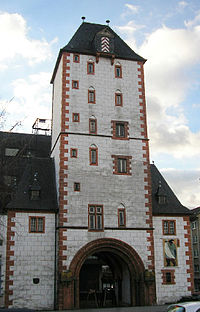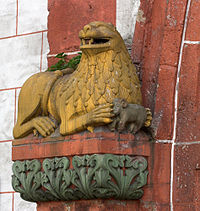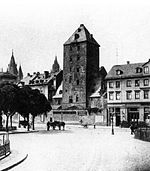Iron Tower (Mainz)
The iron tower in Mainz is a medieval city tower from the beginning of the 13th century with extensions from the 15th century. The name of the building was given by the iron market, which took place in the immediate vicinity until the 19th century. Together with the wooden tower and the Alexander tower , it is one of the three city towers of the Mainz city wall that still exist today .
The iron tower served as a watchtower and city gate as part of the city fortifications and later as a prison . It was badly damaged in World War II and reconstructed in the 1960s. Today the iron tower houses various artist initiatives and associations and serves as a location for artist exhibitions.
Background: The Mainz city fortifications
The city of Mainz had its own city fortifications with walls, towers and city gates since late Roman times . Shortly before the fall of the Limes in 259/260, the first wall ring was built around the city of Mogontiacum. Not long after 350 the city wall of the late antique Mogontiacum was significantly shortened in the course of the abandonment of the legionary camp and expanded and reinforced using older building materials ( Spolia ). After the Romans withdrew, repair work was carried out on the Roman city wall , especially in the Merovingian and Carolingian times. The city wall, referred to as “Roman-Carolingian” in Mainz city archeology, was created.
The continuity of the early medieval city fortifications was drastically interrupted in 1160. After Mainz citizens after prolonged argument with her Archbishop Arnold of Selenhofen (and the Hohenstaufen Emperor Frederick I Barbarossa ) killed them, imposed Emperor Frederick I in 1163 as a punishment the imperial ban over the city. Its city wall including the city towers was razed (according to some historians, however, this was limited to the destruction of the gate towers).
Since the city of Mainz was an important political and strategic ally in the battle of the Hohenstaufen against the Guelphs for supremacy in Germany, permission to rebuild a city fortification was granted as early as 1190/1200. During this construction phase, the iron tower was also built as one of a total of 34 gate and watchtowers.
Architectural style and construction phases
The late Romanesque gate floor of the iron tower with the round arch portal was built in the first half of the 13th century, possibly even around 1200. The arched portal on the Rhine side is decorated with two Romanesque sandstone lion sculptures. They are on ornamented warrior attachments above grooved corner stones. One of the figures holds a ram in its paws, partly interpreted as a symbol of church power. The second lion sculpture holds a mythical creature ( dragon ) in its paws, the symbol of worldly power. The two lion figures are only stylized as is typical of the time and were seen in the Romanesque period as a parable of vigilance ready to defend themselves.
In the first half of the 15th century, the storeys of the tower were increased to a total of six storeys and this increased. Towards the end of the 16th century, possibly even at the beginning of the 14th century, the portal lost its function and access to the city is via the so-called iron door in a smaller building directly attached to the tower.
The iron tower was surrounded by a wall on the Rhine side in the 18th century , which stood until the beginning of the 20th century. Until 1945, smaller half-timbered houses were built on the Löhrstrasse side.
Use in the Middle Ages and in modern times
From its construction until the 16th century, the iron tower served as a city and gate tower as part of the Mainz city fortifications. It owes its representative character to the Rhine front, which was heavily frequented by Rhine shipping in the Middle Ages, and the trading focus of the city on the Rhine. The iron tower, together with the other towers on the Rhine side (wooden tower, fish tower, etc.) formed a secular-architectural contrast to the many church towers in the church town of Mainz.
In the Middle Ages, the market of the Mainz iron merchants was held around the iron tower, which gave the tower its name, which is still used today. From the 17th century the upper tower floors were used as the main prison. Prominent prisoners of the then French Mayence who were locked up in the iron tower were some officers of the Lützow Freikorps in 1813 . After 1848/1849, following the March Revolution , the Mainz revolutionaries were held here as political prisoners until they were acquitted in 1850.
In 1900 the iron tower was supposed to be demolished. The Mainz antiquity association saved the building and the iron tower became the property of the city of Mainz in 1905. After this time, the iron tower housed a painting studio and smaller apartments. In the courtyard formed by the walling on the Rhine side, old stone monuments from Mainz's city history were also temporarily stored.
Destruction and rebuilding
During the Second World War, the iron tower, like the entire city center of Mainz, was badly damaged. The tower burned out completely, as did the roof structure . In 1958 the iron tower was rebuilt and given a new roof, a slate hipped roof. The surrounding walling was laid down in the early 1970s as part of the redesign of the neighboring residential area Zum Brand . To the left and right of the iron tower, reconstructions of the extensions and a piece of the city wall were added, which are supposed to reproduce the medieval ensemble almost true to the original. The corner blocks and the painted joints were also restored according to original finds.
The iron tower today
The iron tower is now home to the Eisenturm Mainz art association . The Mainz artists use the Eisenturm as a gallery and exhibition space and award the Mainz Eisenturm Prize there. Other public institutions and associations, for example the Photo Club Mainz and the Rotaract Club Mainz, have their domicile in the Eisenturm.
The iron tower can be visited as part of the nationwide event Day of the Open Monument .
literature
- Rolf Dörrlamm, Susanne Feick, Hartmut Fischer, Hans Kersting: Mainz contemporary witnesses made of stone. Architectural styles tell 1000 years of history. Hermann Schmidt, Mainz 2001, ISBN 3-87439-525-1 .
- Günther Gillessen (Ed.): If stones could talk. Mainz buildings and their stories. Guided tours through an urban landscape. Philipp von Zabern, Mainz 1991, ISBN 3-8053-1206-7 .
- Ernst Stephan: The community center in Mainz (= The German community center. Vol. 18). Wasmuth, Tübingen 1974, ISBN 3-8030-0020-3 .
See also
Web links
- Historic Mainz: The Iron Tower - mainz.de
- The iron tower - regionalgeschichte.net
- Art Association Eisenturm Mainz
- Mainz Fortress - The medieval city fortifications of Mainz
Coordinates: 50 ° 0 ′ 3.8 ″ N , 8 ° 16 ′ 31.7 ″ E




